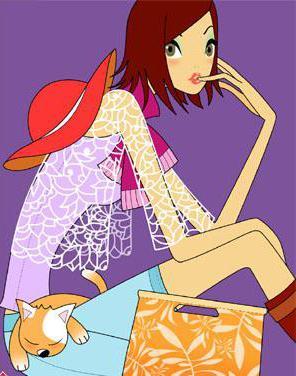| What should we wear during the economic recession? | |
|---|---|
| Mar 22, 2008 02:08 | |
 | As US economy goes to recession, the whole world have been affected not only in the economic area but also in other areas, for example, fashion. The FT Columnist Jonathan Guthrie writes an article about Fashion Crisis. In his article, he writes:" Wouldn’t you know it? You get invited to the first must-attend economic slowdown in ages and you simply haven’t a thing to wear. But it’s tough knowing what clothes to buy. The palette, naturally, should be subdued. Ash grey, maybe? And as for fabric, why not channel that new eco-friendly vibe? Something in organic sackcloth, perhaps?" .... Do you prepare suitable clothes for the economic slidedown? What are you going to wear? Just think about this question. Here is the intact article. Source: FT. First the credit crisis, now the fashion crisis By Jonathan Guthrie Published: February 13 2008 18:18 | Last updated: February 13 2008 18:18 Wouldn’t you know it? You get invited to the first must-attend economic slowdown in ages and you simply haven’t a thing to wear. But it’s tough knowing what clothes to buy. The palette, naturally, should be subdued. Ash grey, maybe? And as for fabric, why not channel that new eco-friendly vibe? Something in organic sackcloth, perhaps? Fashion businesses are feeling the pinch, judging from a visit I made to London Fashion Week that coincided with the release of lousy UK garment sales figures. On the surface it was business as usual down in South Kensington: espresso shots, air-kissing and insane hats resembling gold lamé flowerpots. But on the fringes there were ominous outbreaks of eye-rolling over disappointing footfall. My soundings suggested we are facing a global fashion crisis. At any moment consumers might choose en masse not to buy clothes they don’t really need and which, in some cases, make them look faintly ridiculous. Yes, it could really get that bad. This matters even if you are the sort of chap whose interest in fashion is so minimal that his wife orders his leisure clothes in bulk from the Boden catalogue. Upmarket fashion trends drive retail sales when “adapted” for the high street (“ripped off” is so perjorative, I always think). That helps keep money circulating. When the average shopper decides she would be seen dead in last season’s knitted tank top, the music really is stopping. Retail guru George Davies, who created the Per Una brand for Marks and Spencer, told me: “The fashion industry is very sensitive and the mood is currently cautious.” On a recent tour of Per Una outlets, Mr Davies found women were not buying clothes ahead for anything resembling a “season”, just making one-off purchases on impulse or from necessity. They had quit the forward market to deal spot. |
| Mar 22, 2008 02:09 | |
 | The LFW exhibition area for independent labels was as deserted as the poultry aisle of a supermarket after an avian flu scare when I dropped by. “Footfall is down,” said William Stewart-Brown, UK representative of Indian designer Rohit Bal. “The climate is very tough because of the credit crunch.” The models stalking the catwalk at a fashion show I attended looked equally disgruntled. But you would too if a couple of Marlboro Lights and a celery stick were all you could expect at dinner time. One etiolated figure was wrapped in a garment like a miniature black duvet. Lisa Murray-Peacock, a Debenhams design boss, explained that “cocooning” was a big trend. Well-dressed women are apparently wrapping themselves in protective layers of clothes, in reaction to economic instability and the Clash of Civilisations. The way things are going, they could soon be wearing Kevlar waistcoats with their life savings sewn into the linings. Piquant, therefore, to see hot talent Christopher Kane exhibiting a rah-rah dress in an army camouflage print. This should help the wearer to avoid attracting mujahideen rocket fire if she wanders into a war zone on her way back from the boutique. The correlation between fashion and the broader zeitgeist should not be exaggerated. But it is true that Dior’s flamboyant New Look marked a revolt against postwar austerity drives in which the authorities urged women to reduce waste by making hats from carpet offcuts. The idea that skirt lengths rise and fall in line with the economy has, meanwhile, gained underpinning from the lower hems displayed at some catwalk shows this week. I could find little consensus at London Fashion Week on the impact the downturn might have on consumer behaviour. Some fashionistas thought customers would buy an expensive dress or two and lay off the tops. Others expected a tops splurge to compensate for retrenchment in dress-related capex. |
| Mar 22, 2008 02:09 | |
 | Everyone kept saying: “The super-rich are always with us.” By the end of the day it sounded like a prayer. However, the super-rich are pretty thinly spread, even in modern London. It is the moderately loaded whom purveyors of luxury goods should worry about. Their fortunes are dipping along with those of the financial services businesses so many of them work for. Hannah Marshall, a young designer whose clothes are targeted at women executives, was nevertheless upbeat when I ran into her in exhibition space devoted to emerging talent. The show organisers had mystifyingly themed this as a genuine cockney pub, staffed by fashionable people pretending to be genuine cockneys. But even the flock wallpaper and stag heads could not damp Ms Marshall’s spirits at surviving for three seasons. Most wannabe Vivienne Westwoods run out of cash sooner. It costs upward of £15,000 for a fledgling designer to create and show a collection, even when the venue is free. Ms Marshall has funded her career with savings, government grants and a loan from a bank that thought it was financing the purchase of a car. She is receiving steady orders and “getting close to break even”. Her frocks could catch the mood of the times, being austere and available in any colour as long as it is black. Moreover, she has a business plan, an accessory eschewed by cavalier counterparts. She is in with a shot. Some young designers need to survive the shmutter trade apocalypse. Otherwise, when we emerge from our underground shelters, big retailers will have no one to pinch fashion ideas from. |
| Mar 22, 2008 18:12 | |
 | My fashion taste has always been limited to Walmart whether the economy has been good or bad(even though I don't believe in their philosophy of squeezing out the small retailer). By the way, CCTV9 always shows segments of fashion reviews? |
| Mar 22, 2008 19:55 | |
 | LOL! Seriously? As for me, I don’t change my lifestyle depending on the economy. In good times and in bad times, I wear the same kinds of clothes. “At any moment consumers might choose en masse not to buy clothes they don’t really need and which, in some cases, make them look faintly ridiculous. Yes, it could really get that bad.” What is so bad about that? Why buy clothes that they don’t really need in the first place? And if times are really that bad, looking ridiculous is the least of their problem. |
| Mar 24, 2008 21:22 | |
 | Shall we dress depressively just because the economy is recessionary? ^_^ |
Post a Reply to: What should we wear during the economic recession?








 Copyright © 1998-2025 All rights reserved.
Copyright © 1998-2025 All rights reserved.